Development and Application of Digital Twin–BIM Technology for Bridge Management
Abstract
:1. Introduction
2. PC Box-Girder Bridge of Comoro
3. Digital Twin and BIM Strategy
3.1. Digital Twin
3.2. Building Information Modeling (BIM)
3.3. Development of a Digital Twin–BIM Model for Bridge Management Workflows
4. Building Information Management
4.1. BIM Management Applications Using Digital Twin of Comoro Bridge
4.2. Digital Twin of Comoro Bridge for Landscape Visualization
4.3. Digital Twin of Comoro Bridge for Traffic Flows Simulation
- ▪
- To assess the effectiveness of the Comoro Bridge in mitigating traffic congestion in the City of Dili.
- ▪
- To validate the capabilities of advanced BIM technology in designing and managing transportation infrastructure.
- ▪
- To demonstrate the efficacy of BIM technology applications in the architecture, engineering, and construction (AEC) industry.
4.4. Digital Twin of Comoro Bridge for Structural Performance Evaluation
4.4.1. Digital Twin–BIM Technology and Finite Element Analysis Interoperability
- The complete Comoro Bridge model was developed using BIM tools.
- A simplification process was conducted to remove secondary elements such as railings, electrical poles, pedestrians, and other nonessential components.
- The IFC format was utilized for seamless interoperability between BIM and FE analysis (FEA).
- After achieving interoperability, the bridge model was prepared for the FE analysis (FEA).
- The finite element analysis (FEA) was performed.
- Results and evaluations are conducted.
4.4.2. Structural Performance Evaluation Based on FE Analysis
- Full-Scale Model Creation for FE Analysis
- Material Properties
- Boundary ConditionsThe boundary conditions applied in this analysis were as follows:
- ➢
- The bottoms of pile caps and abutments were idealized as fixed supports. They were rigidly connected to the ground with translations (T1, T2, and T3) constrained, as illustrated in Figure 16.
- ➢
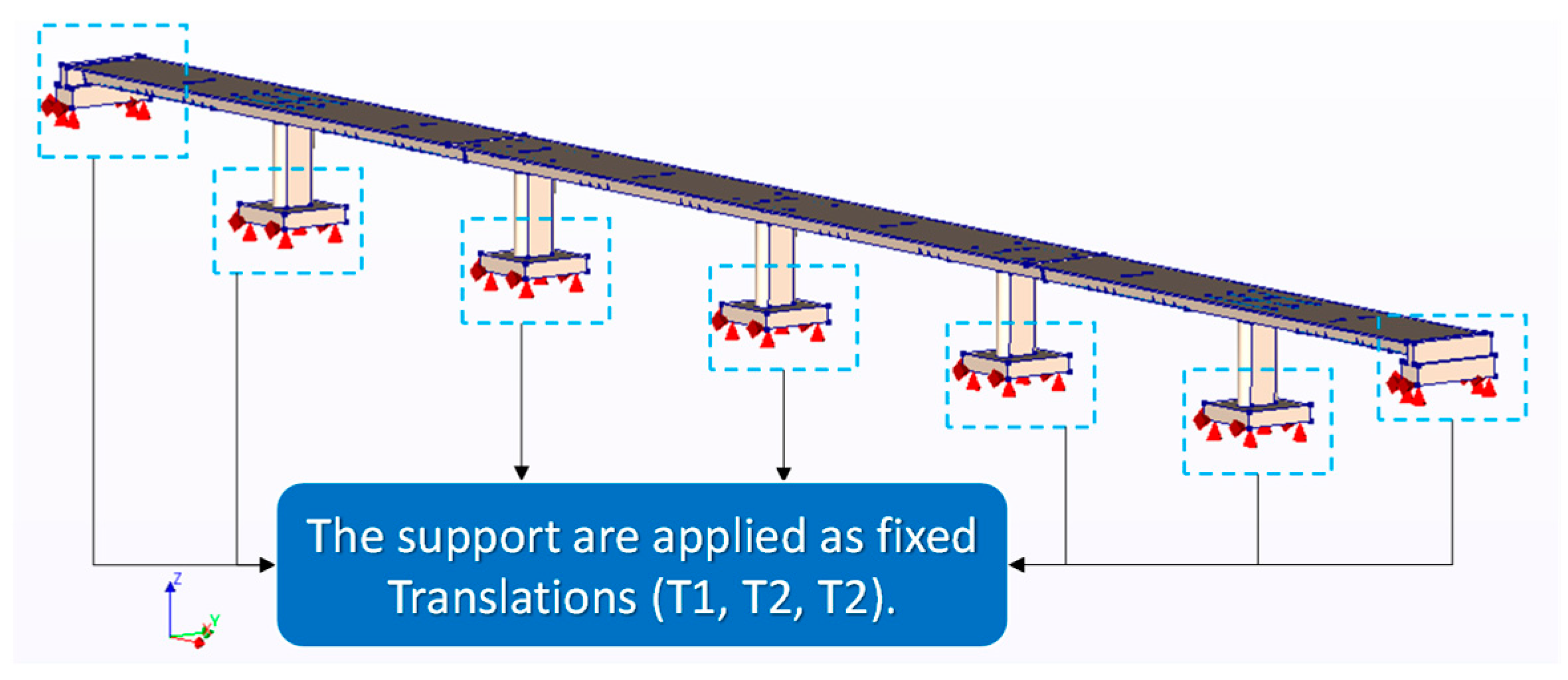

| Location | Direction | Theoretical B. C. | Analysis | ||
|---|---|---|---|---|---|
| B. C. | Stiffness | ||||
| A1 | Sway deformation | Fix | Rigidly fixed by spring element | ||
| Rotational deformation | Fix | Constrained by spring element | |||
| Free | |||||
| Fix | |||||
| P1–P5 | Sway deformation | Fix | Rigidly fixed by spring element | ||
| Rotational deformation | Fix | Constrained by spring element | |||
| Free | |||||
| Fix | |||||
| A2 | Sway deformation | Fix | Rigidly fixed by spring element | ||
| Rotational deformation | Fix | Constrained by spring element | |||
| Free | |||||
| Fix | |||||
- Loads
- Self-weight (DL): represents the weight of all structural elements of the bridge.
- Superimposed dead load (SDL): Includes the weight of the steel railing, asphalt concrete pavement, safety fences, and other components. The combined value of this load was 50 kN/m.
- Prestress Tendon (T): represents the tendons just after prestressing with a stress of 1295 N/mm2.
- Discretization (“Meshing”)
- Analysis Type
- Structural Evaluation for state conditions of Comoro Bridge
- ▪
- Displacement
- ▪
- Normal stress distribution
- ▪
- Shear-Stress distribution
- Sectional force (Coefficient Z value)
- Nonuniform normal stress (Shear-lag) distribution on box-girder section
- ▪
- Shear-Lag Effect Evaluation on PC Box-Girder Section
- ▪
- Shear-lag effect Evaluation
- The nonuniform normal stress distribution due to the shear-lag effect obviously occurred at the top and bottom flanges.
- The shear-lag effect significantly occurred at the top of the piers, especially at the web and flanges interactions.
- However, when it moved towards the midspan, the shear-lag effect was diminished linearly and could even be neglected.
- Shear-Lag Effect at Double-Cell Box Vs. Single-Cell Box Girder
- ▪
- The shear-lag effect was observable at the top and bottom flanges in the box-girder section located at the top of the piers, as depicted in Figure 30a.
- ▪
- The results indicated that the shear-lag effect was more prominent in the single-cell box compared to the double-cell box. This disparity was attributable to the geometrical differences, with the double-cell box featuring an intermediate web, while the single-cell box lacked one (refer to Figure 30b,c).
- Both the double-cell and single-cell boxes exhibited a shear-lag effect, especially at the top of the piers.
- As the location progressed towards the midspan, the shear-lag effect diminished linearly and became aligned with the assumptions of the Euler–Bernoulli beam theory.
- At the midspan in the case of the double-cell box, the shear-lag effect was minimal and closely resembled the behavior predicted by beam theory. However, in the single-cell box, where no middle web was installed, the shear-lag effect slightly increased compared to that of the double-cell box.
4.5. Application of Bridge Digital Twin for Structure Maintenance
5. Conclusions
- ▪
- The development and application of digital twin-BIM technology for bridge management offer significant advantages in the field of infrastructure maintenance and operation. By integrating the capabilities of digital twin technology with building information modeling (BIM), bridge managers can create a comprehensive virtual representation of the bridge, capturing its physical and functional attributes.
- ▪
- Digital twin–BIM technology enables the landscape visualization of the Comoro Bridge with the surrounding environment, traffic flow simulation at the area of the target bridge, a finite element analysis for bridge structure performance evaluation, and bridge structure maintenance. Therefore, digital twin–BIM technology has the potential and ability to access accurate and up-to-date information about the bridge’s condition that enhances asset management practices, optimizes maintenance schedules, and extends the lifespan of the structure.
- ▪
- Additionally, digital twin–BIM technology promotes an effective collaboration among stakeholders involved in bridge management, allowing seamless data exchange, information sharing, and coordinated decision-making. This enhances communication, reduces errors, and streamlines workflows, leading to improved efficiency and cost-effectiveness in bridge maintenance and operation.
- ▪
- Furthermore, the utilization of digital twin–BIM technology in bridge management contributes to enhanced safety by enabling the evaluation of the structural integrity, the assessment of risk factors, and the implementation of preventive measures. This proactive approach minimizes the likelihood of bridge failures, ensuring the safety of users and surrounding areas.
Author Contributions
Funding
Institutional Review Board Statement
Informed Consent Statement
Data Availability Statement
Conflicts of Interest
References
- Tao, F.; Zhang, H.; Liu, A.; Nee, A.Y.C. Digital Twin in Industry: State-of-the-Art. IEEE Trans. Ind. Inform. 2019, 15, 2405–2415. [Google Scholar] [CrossRef]
- Turner, C.J.; Oyekan, J.; Stergioulas, L.; Griffin, D. Utilizing Industry 4.0 on the Construction Site: Challenges and Opportunities. IEEE Trans. Ind. Inform. 2021, 17, 746–756. [Google Scholar] [CrossRef]
- Broo, D.G.; Bravo-Haro, M.; Schooling, J. Design and implementation of a smart infrastructure digital twin. Autom. Constr. 2022, 136, 104171. [Google Scholar] [CrossRef]
- Sanfilippo, F.; Thorstensen, R.T.; Jha, A.; Jiang, Z.; Robbersmyr, K.G. A Perspective Review on Digital Twins for Roads, Bridges, and Civil Infrastructures. In Proceedings of the 2022 International Conference on Electrical, Computer, Communications and Mechatronics Engineering (ICECCME), Maldives, 16–18 November 2022; pp. 1–6. [Google Scholar] [CrossRef]
- Gao, Y.; Qian, S.; Li, Z.; Wang, P.; Wang, F.; He, Q. Digital Twin and Its Application in Transportation Infrastructure. In Proceedings of the 2021 IEEE 1st International Conference on Digital Twins and Parallel Intelligence (DTPI), Beijing, China, 15 July–15 August 2021; pp. 298–301. [Google Scholar]
- Opoku, D.-G.J.; Perera, S.; Osei-Kyei, R.; Rashidi, M. Digital twin application in the construction industry: A literature review. J. Build. Eng. 2021, 40, 102726. [Google Scholar] [CrossRef]
- Salamone, S.; Bartoli, I.; Phillips, R.; Nucera, C.; di Scalea, F.L. Health Monitoring of Prestressing Tendons in Posttensioned Concrete Bridges. Transp. Res. Rec. J. Transp. Res. Board 2011, 2220, 21–27. [Google Scholar] [CrossRef]
- Yu, S.; Li, D.; Ou, J. Digital twin-based structure health hybrid monitoring and fatigue evaluation of orthotropic steel deck in cable-stayed bridge. Struct. Control Health Monit. 2022, 29, 2976. [Google Scholar] [CrossRef]
- Gao, Y.; Li, H.; Xiong, G.; Song, H. AIoT-informed digital twin communication for bridge maintenance. Autom. Constr. 2023, 150, 104385. [Google Scholar] [CrossRef]
- Jiang, F.; Ma, L.; Broyd, T.; Chen, K. Digital twin and its implementations in the civil engineering sector. Autom. Constr. 2021, 130, 103838. [Google Scholar] [CrossRef]
- Dan, D.; Ying, Y.; Ge, L. Digital Twin System of Bridges Group Based on Machine Vision Fusion Monitoring of Bridge Traffic Load. IEEE Trans. Intell. Transp. Syst. 2022, 23, 22190–22205. [Google Scholar] [CrossRef]
- Hidayat, F.; Supangkat, S.H.; Hanafi, K. Digital Twin of Road and Bridge Construction Monitoring and Maintenance. In Proceedings of the 2022 IEEE International Smart Cities Conference (ISC2), Pafos, Cyprus, 26–29 September 2022; pp. 1–7. [Google Scholar] [CrossRef]
- Sofia, H.; Anas, E.; Faiz, O. Mobile Mapping, Machine Learning and Digital Twin for Road Infrastructure Monitoring and Maintenance: Case Study of Mohammed VI Bridge in Morocco. In Proceedings of the 2020 IEEE International Conference of Moroccan Geomatics (Morgeo), Casablanca, Morocco, 11–13 May 2020; pp. 1–6. [Google Scholar] [CrossRef]
- Rios, A.J.; Plevris, V.; Nogal, M. Bridge management through digital twin-based anomaly detection systems: A systematic review. Front. Built Environ. 2023, 9, 1176621. [Google Scholar] [CrossRef]
- Zhao, H.; Tan, C.; Obrien, E.J.; Zhang, B.; Uddin, N.; Guo, H. Developing Digital Twins to Characterize Bridge Behavior Using Measurements Taken under Random Traffic. J. Bridg. Eng. 2022, 27, 04021101. [Google Scholar] [CrossRef]
- Mahmoodian, M.; Shahrivar, F.; Setunge, S.; Mazaheri, S. Development of Digital Twin for Intelligent Maintenance of Civil Infrastructure. Sustainability 2022, 14, 8664. [Google Scholar] [CrossRef]
- Kaewunruen, S.; AbdelHadi, M.; Kongpuang, M.; Pansuk, W.; Remennikov, A.M. Digital Twins for Managing Railway Bridge Maintenance, Resilience, and Climate Change Adaptation. Sensors 2022, 23, 252. [Google Scholar] [CrossRef] [PubMed]
- Nicoletti, V.; Martini, R.; Carbonari, S.; Gara, F. Operational Modal Analysis as a Support for the Development of Digital Twin Models of Bridges. Infrastructures 2023, 8, 24. [Google Scholar] [CrossRef]
- Shim, C.-S.; Dang, N.-S.; Lon, S.; Jeon, C.-H. Development of a bridge maintenance system for prestressed concrete bridges using 3D digital twin model. Struct. Infrastruct. Eng. 2019, 15, 1319–1332. [Google Scholar] [CrossRef]
- Ye, C.; Kuok, S.-C.; Butler, L.J.; Middleton, C.R. Implementing bridge model updating for operation and maintenance purposes: Examination based on UK practitioners’ views. Struct. Infrastruct. Eng. 2021, 18, 1638–1657. [Google Scholar] [CrossRef]
- Nishimura, Y.; Watanabe, G.; Arii, K.; Imada, Y. Real-Time Trend Estimation of Daily Fluctuation Based on Gnss Displacement Observation on a Steel Truss Bridge. In Proceedings of the Transaction of the Ai-Data Science Symposium, Tokyo, Japan, 16–17 November 2022; Volume 3, pp. 621–630. (In Japanese). [Google Scholar]
- Arii, K.; Watanabe, G.; Takechi, K.; Shimizu, N. Automatic Continuous 3D Displacement Monitoring of Bridges Using Static Positioning System; In Press; JSCE: Tokyo, Japan, 2023; Volume 79. (In Japanese) [Google Scholar]
- Lin, Z.; Zhao, J. Revisit of AASHTO Effective Flange-Width Provisions for Box Girders. J. Bridg. Eng. 2011, 16, 881–889. [Google Scholar] [CrossRef]
- Lertsima, C.; Chaisomphob, T.; Yamaguchi, E. Stress concentration due to shear lag in simply supported box girders. Eng. Struct. 2004, 26, 1093–1101. [Google Scholar] [CrossRef]
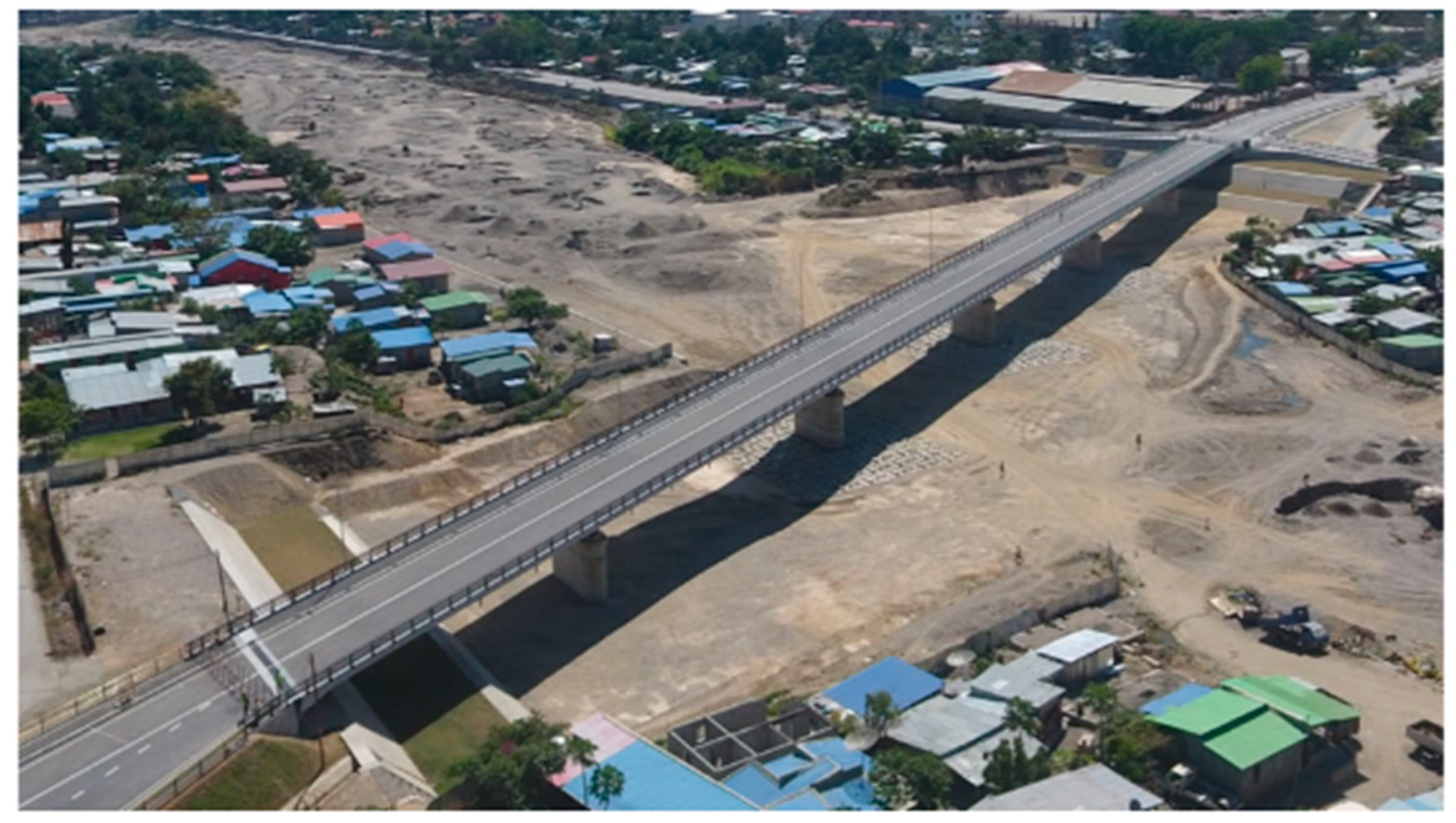
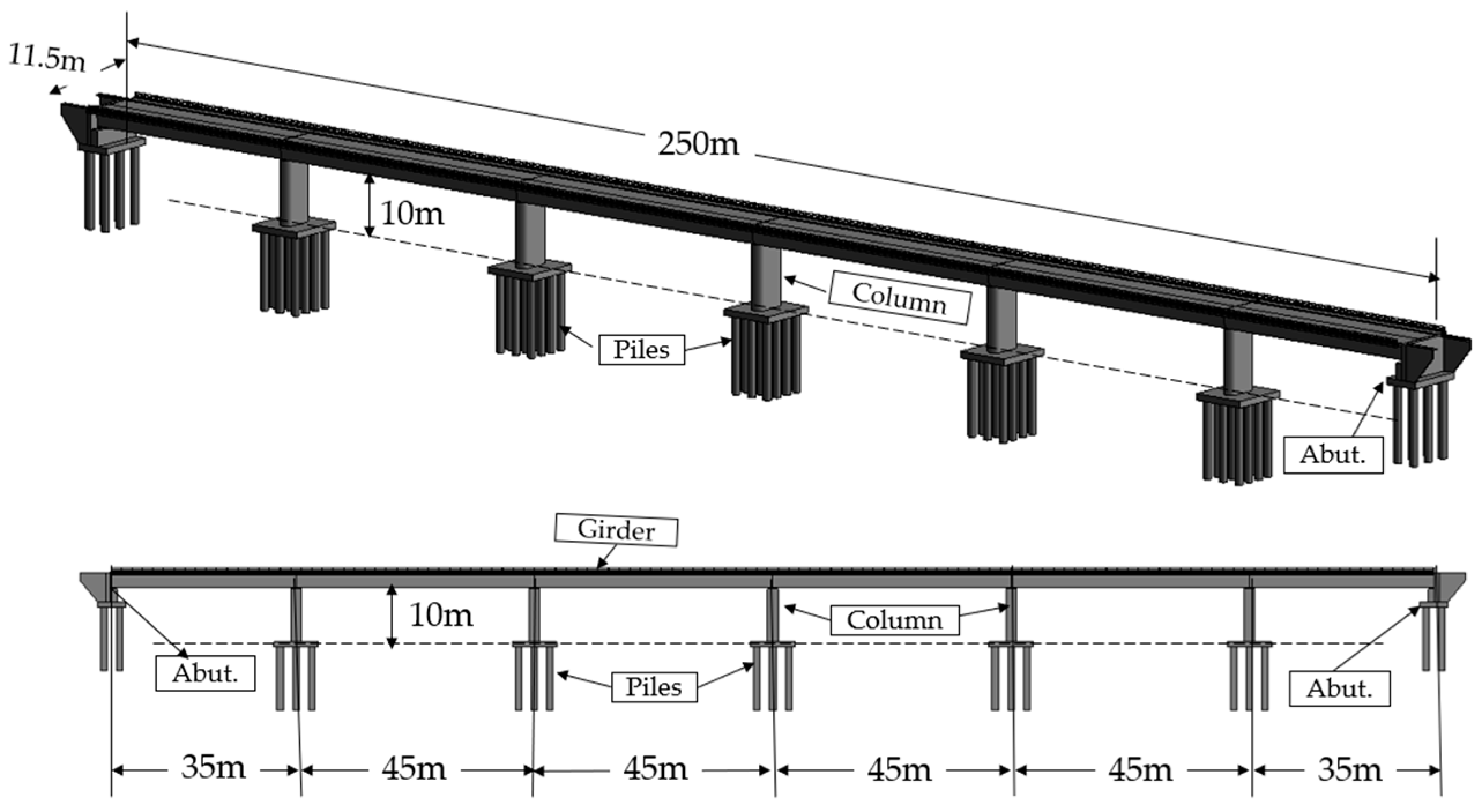

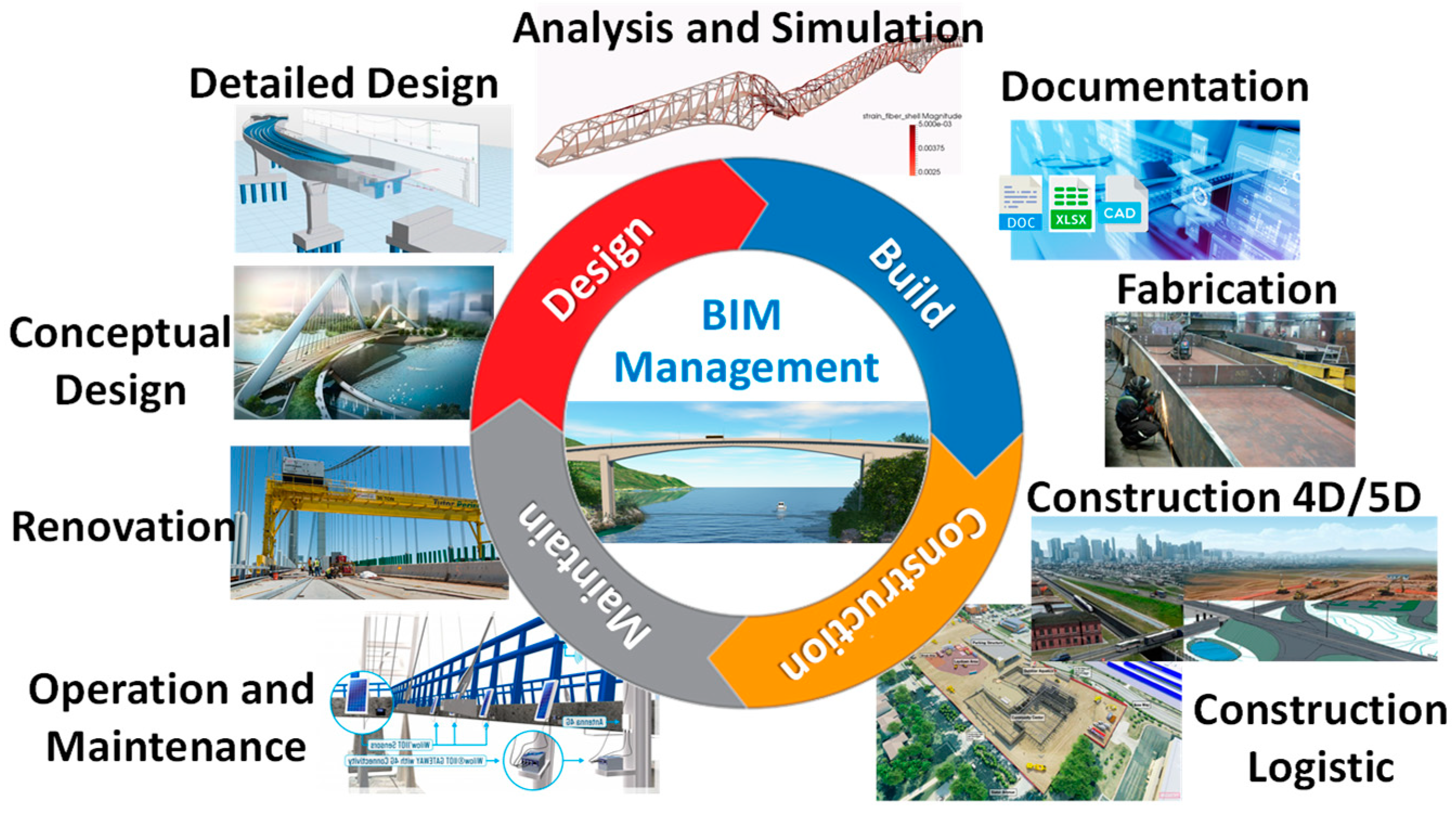
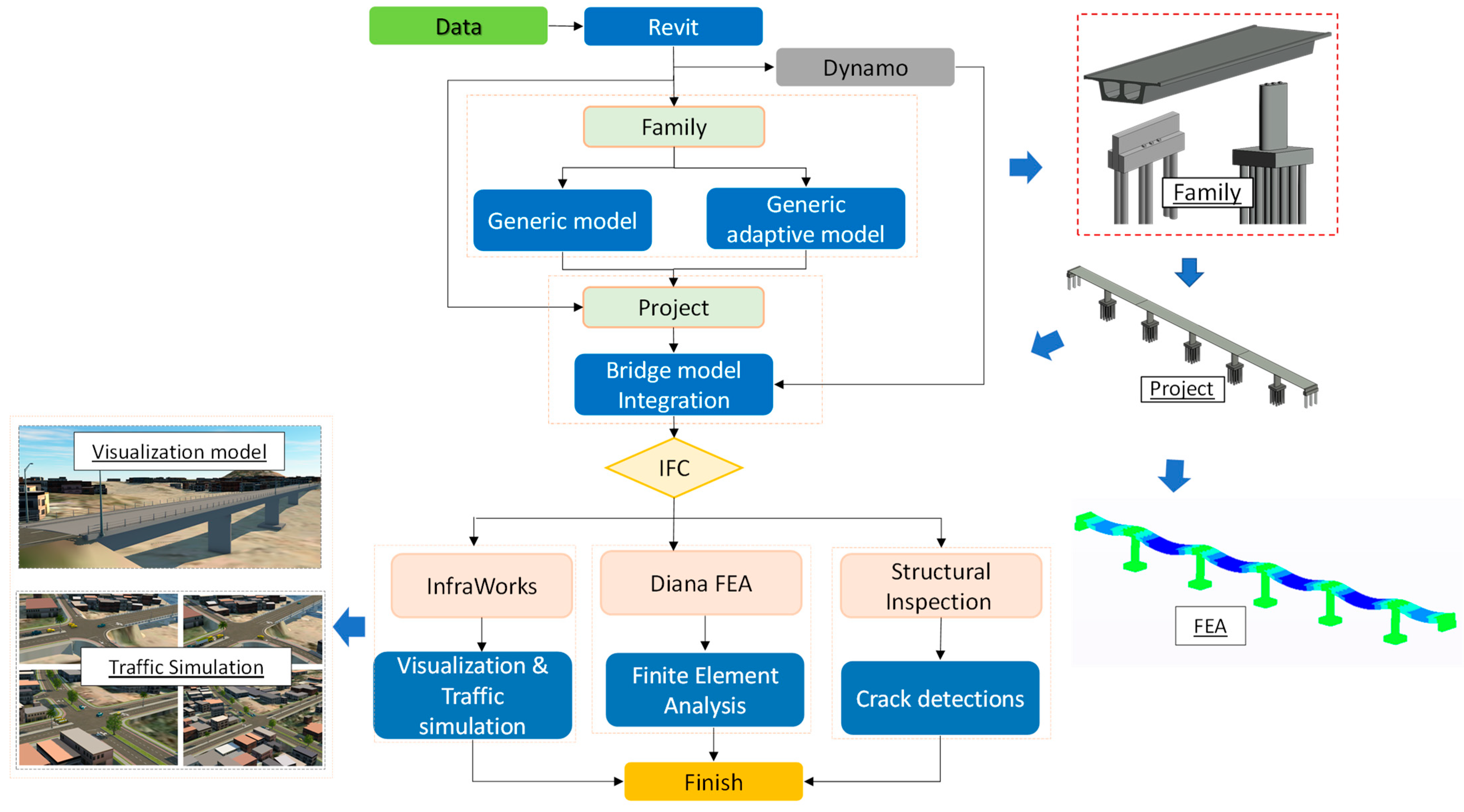
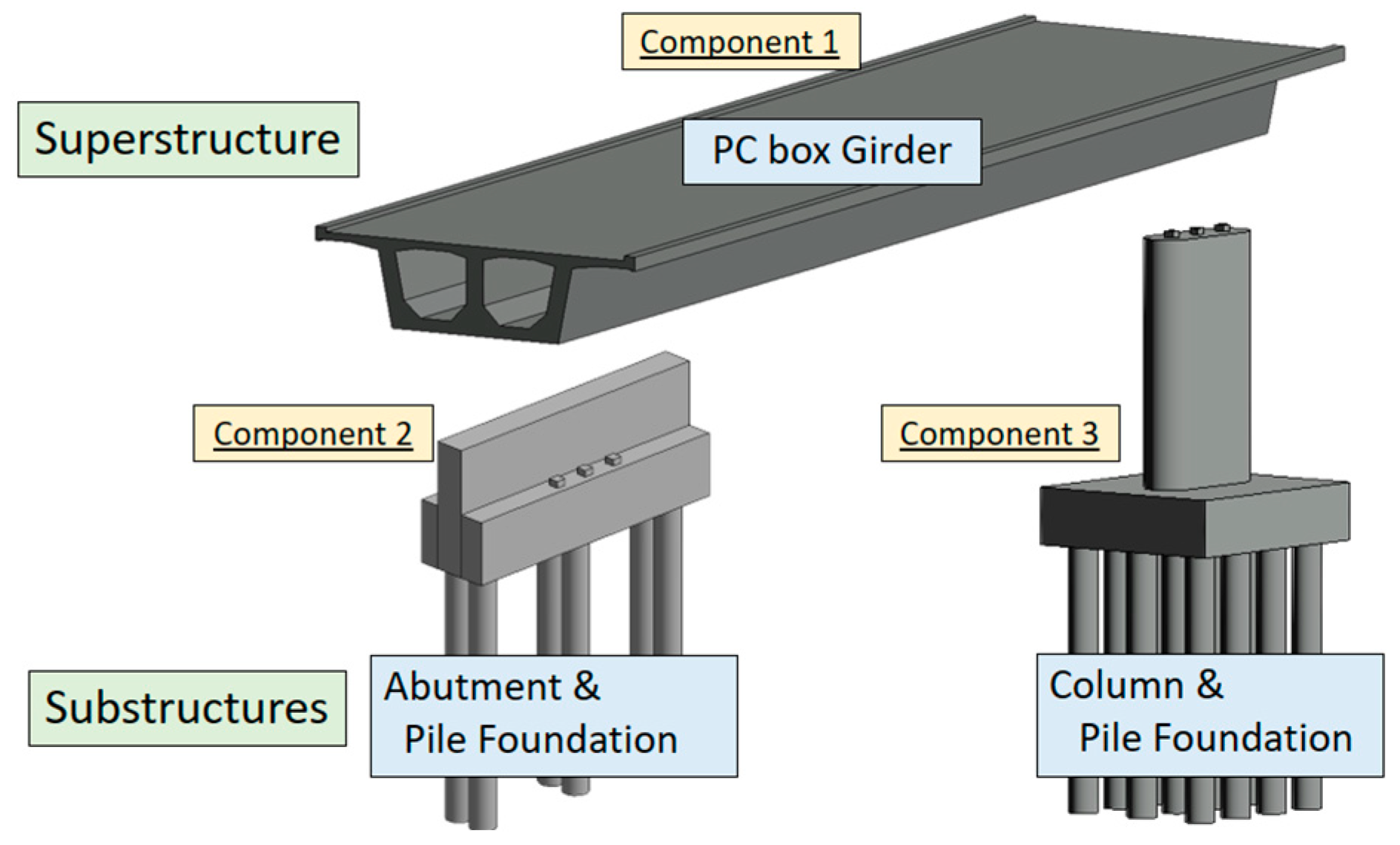
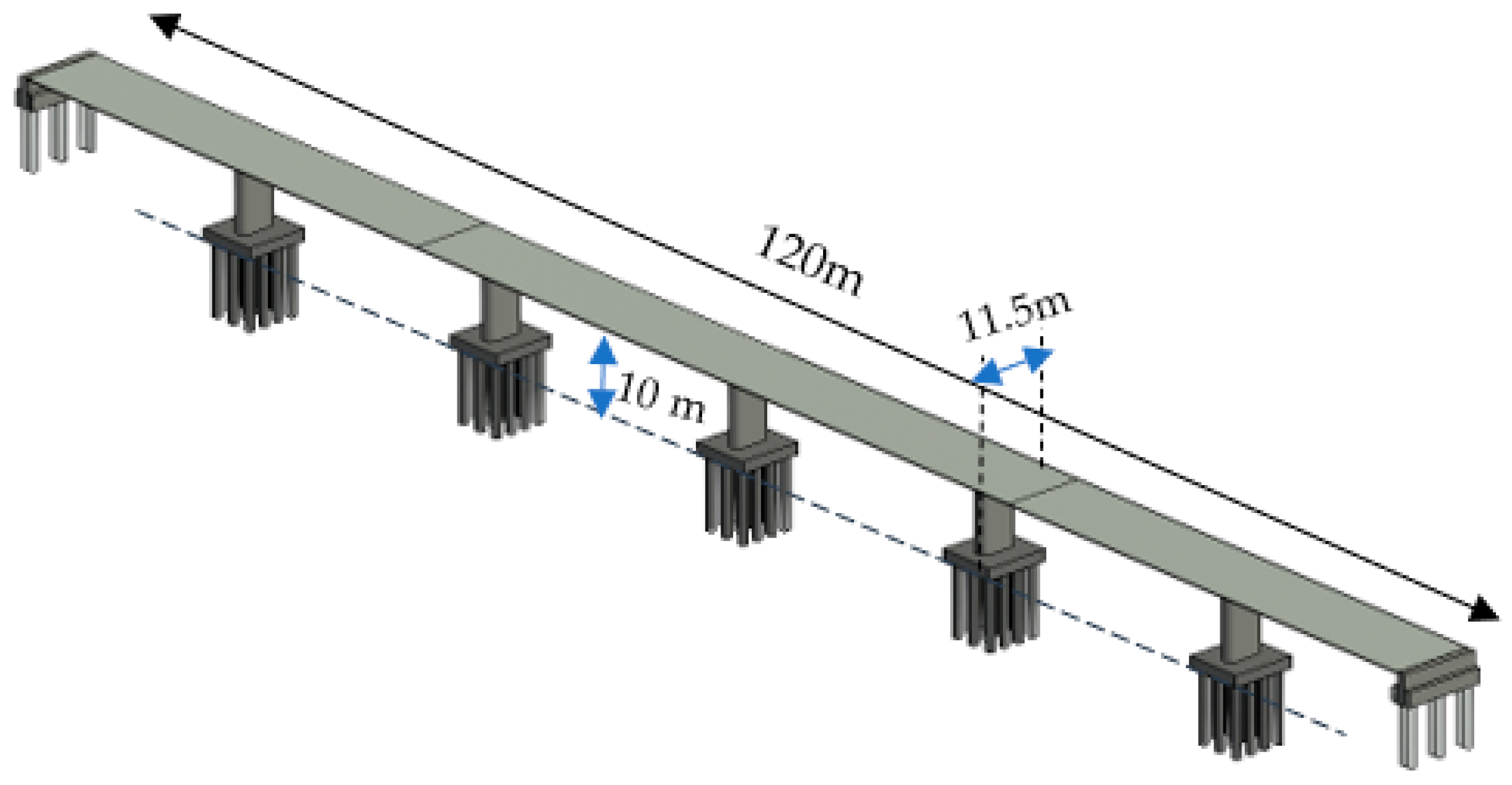
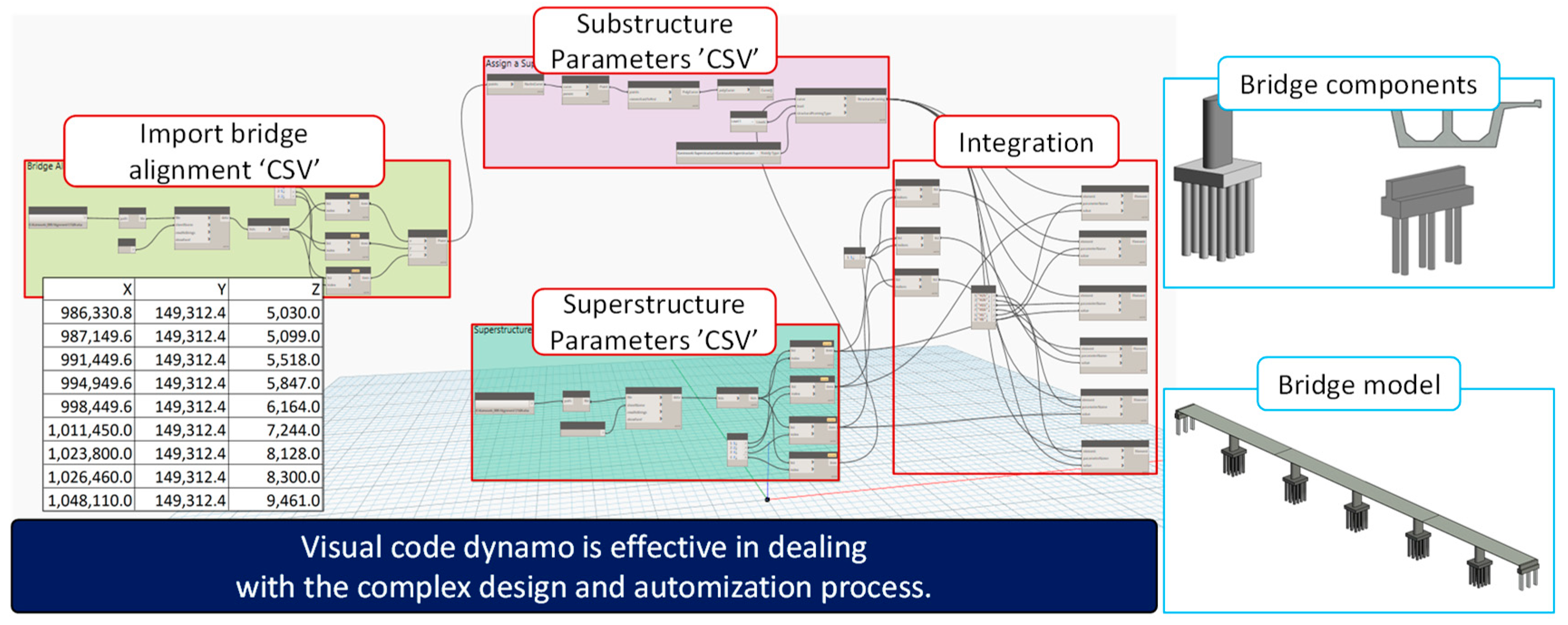

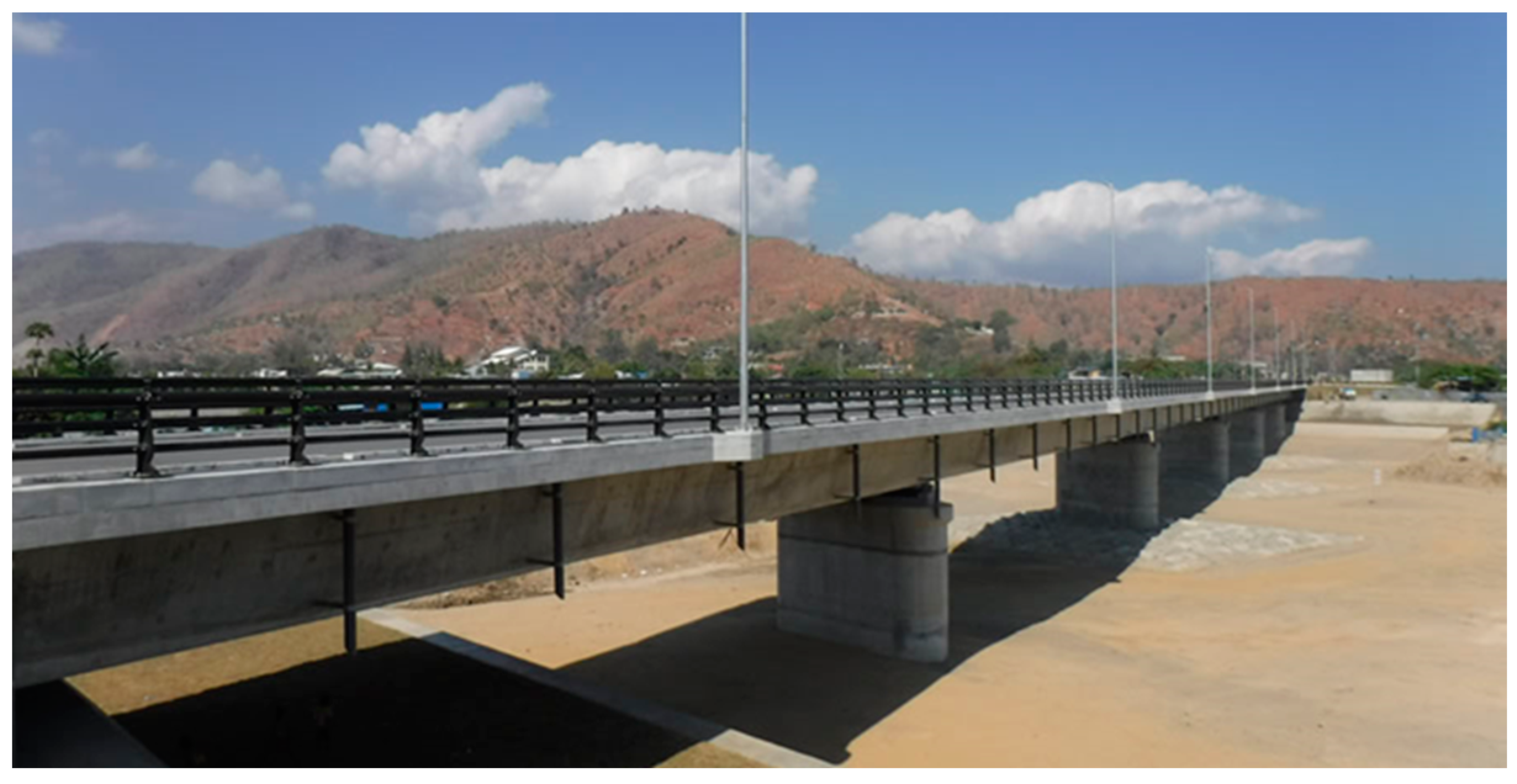
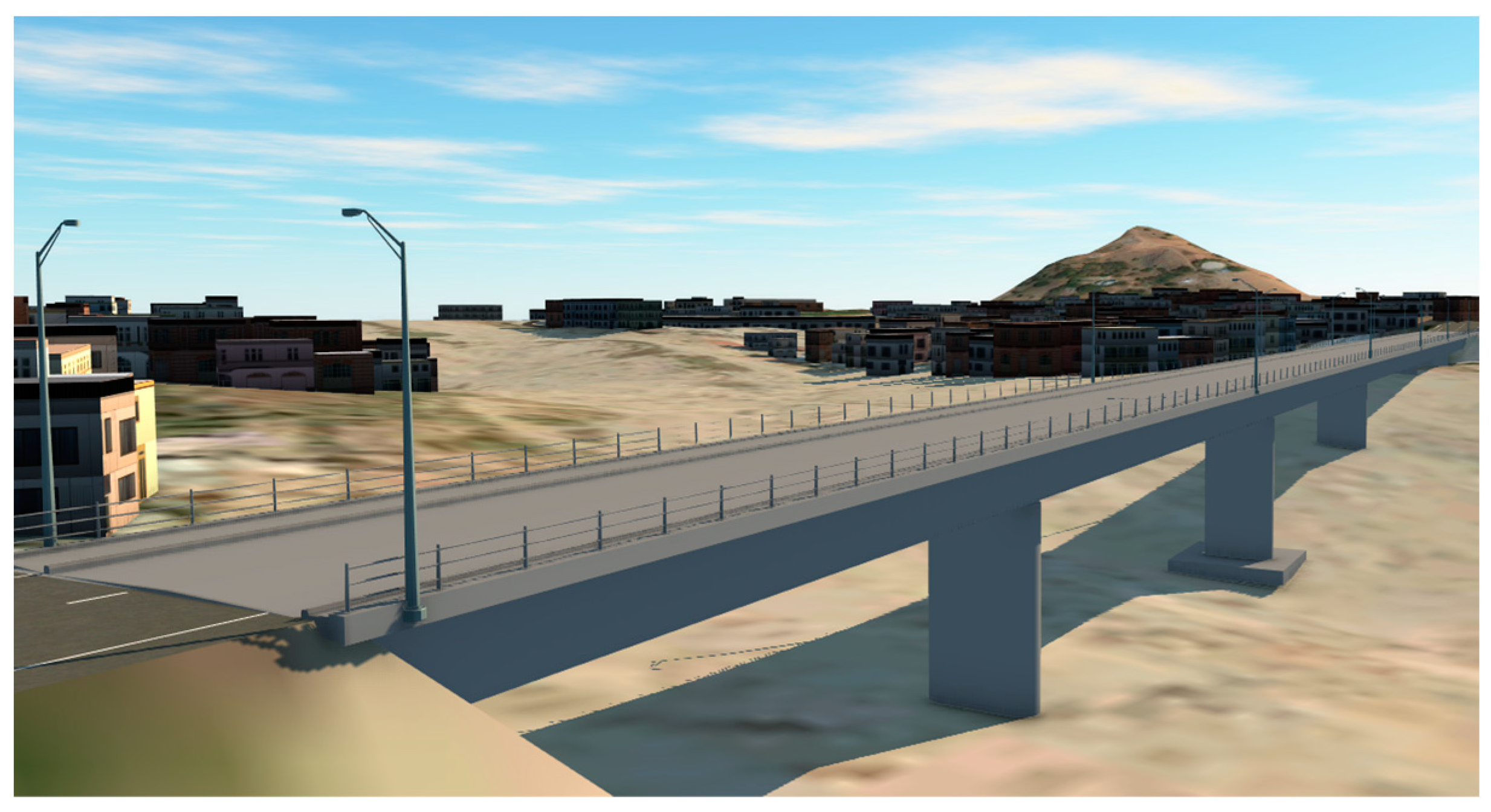
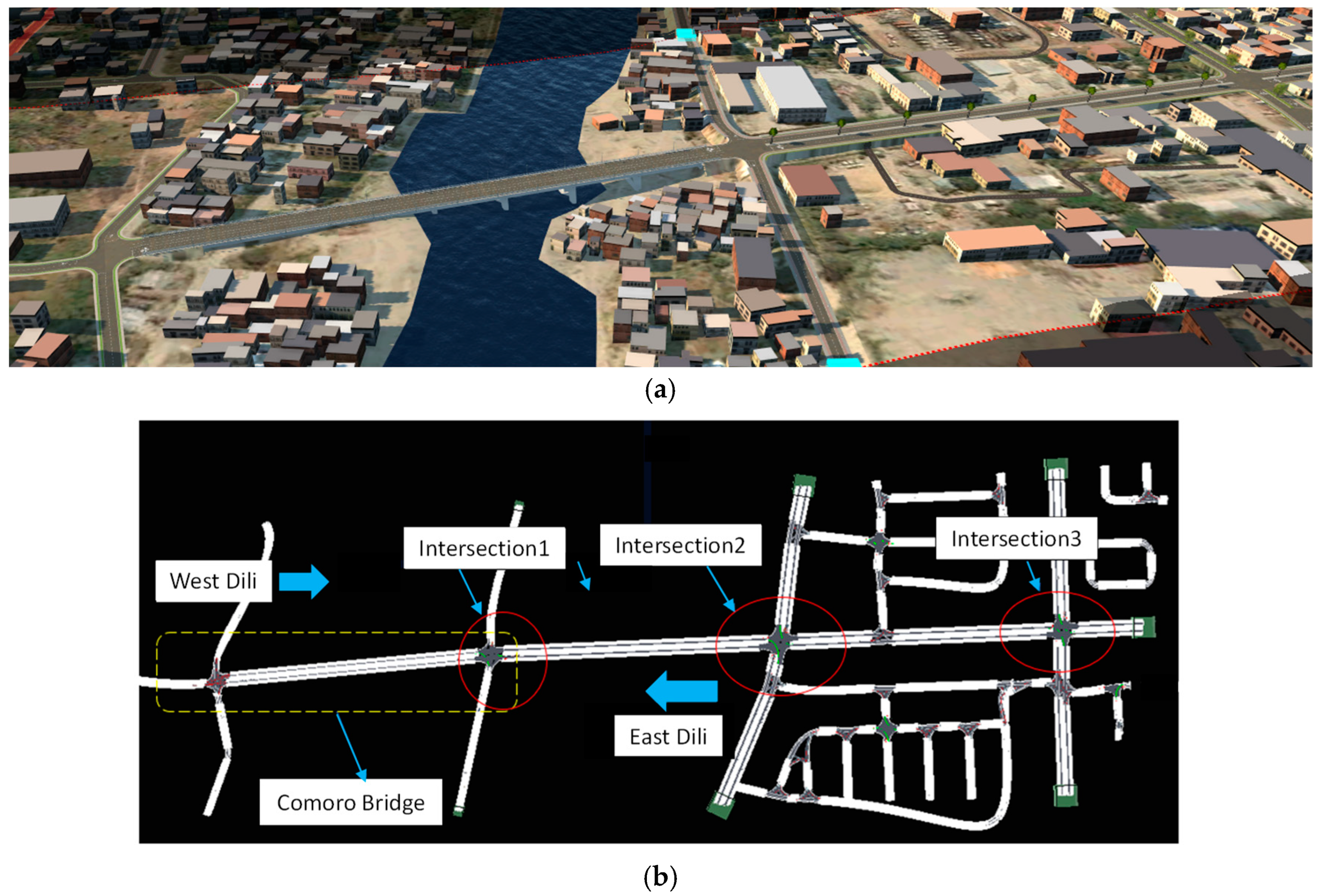
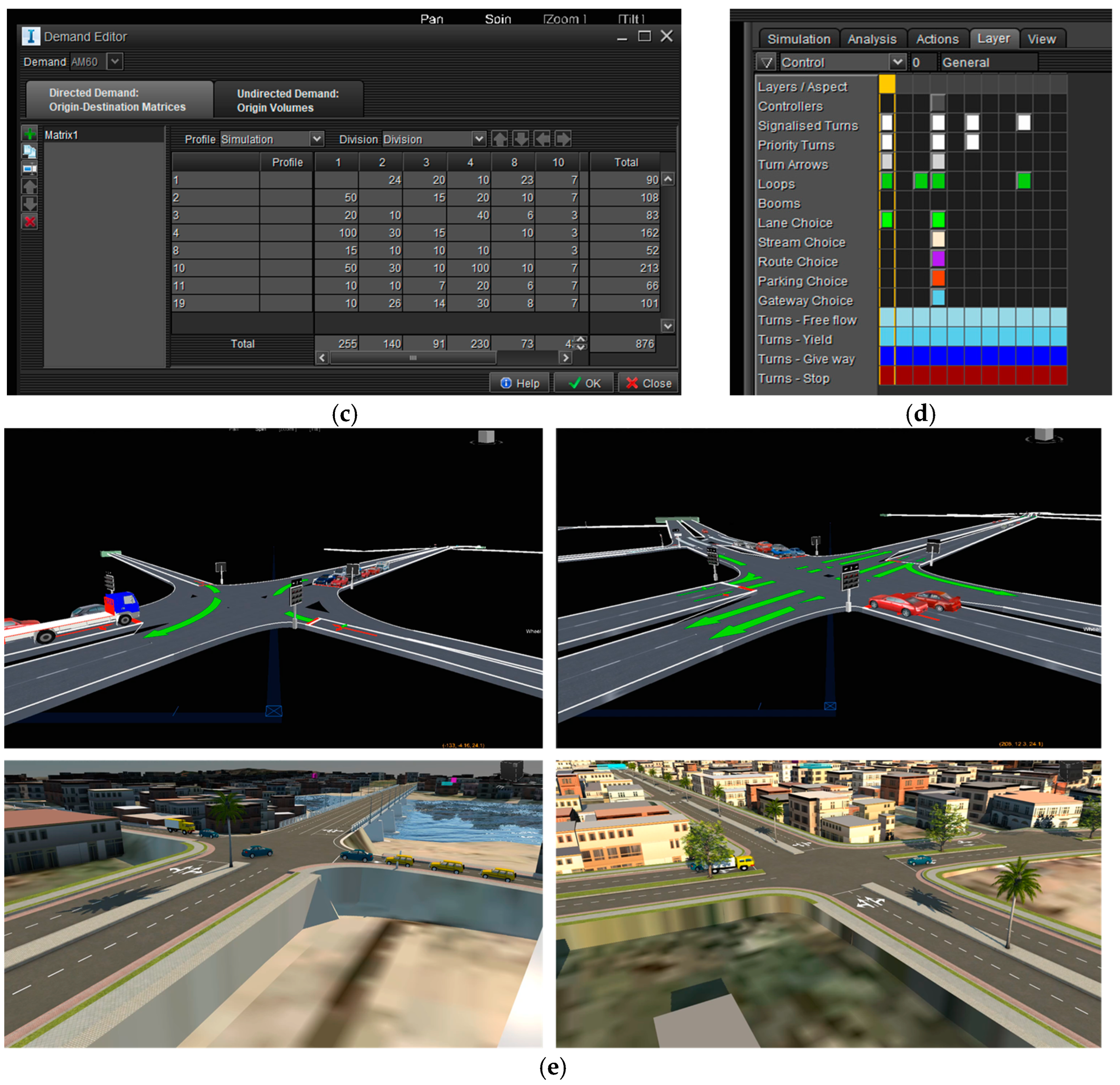
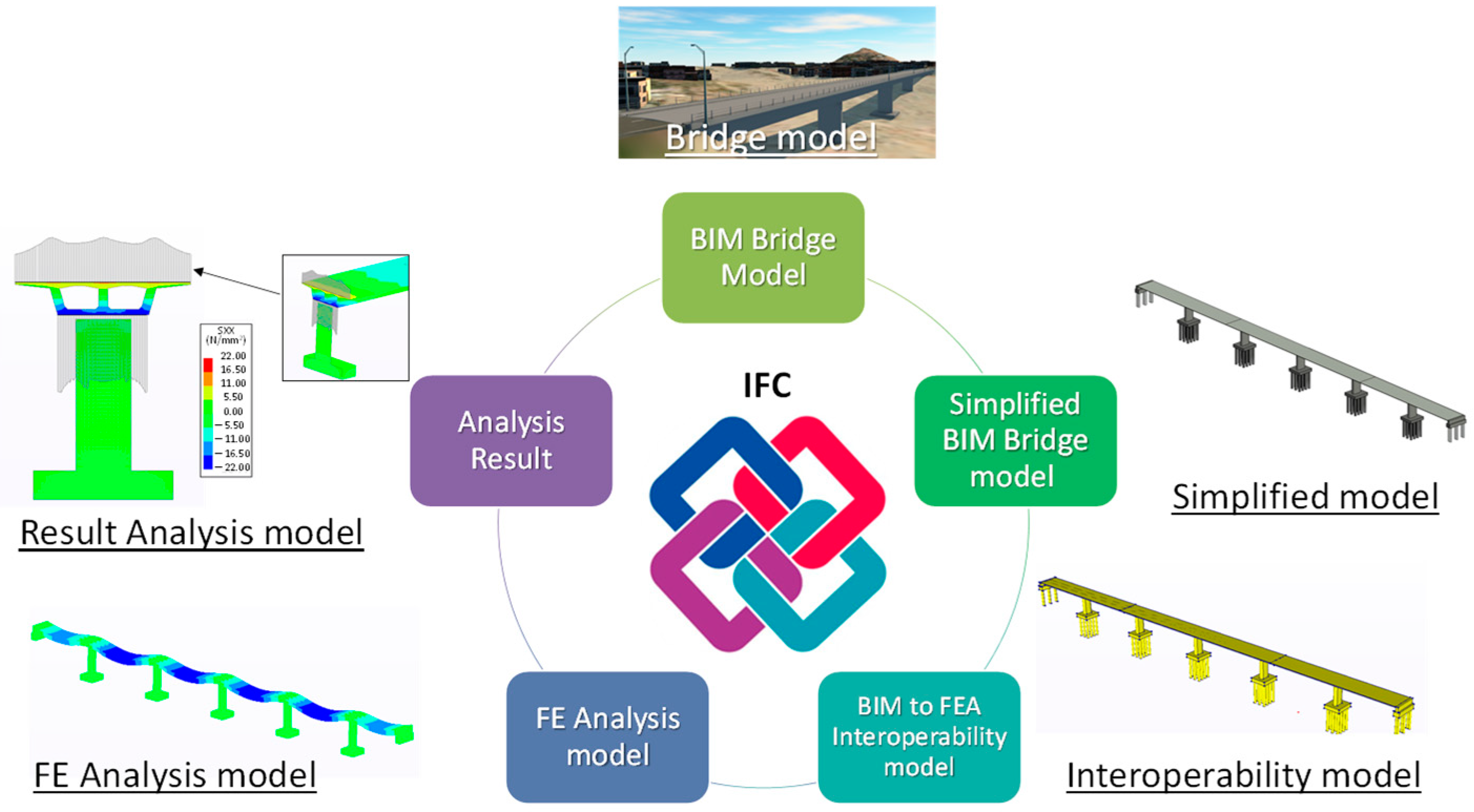

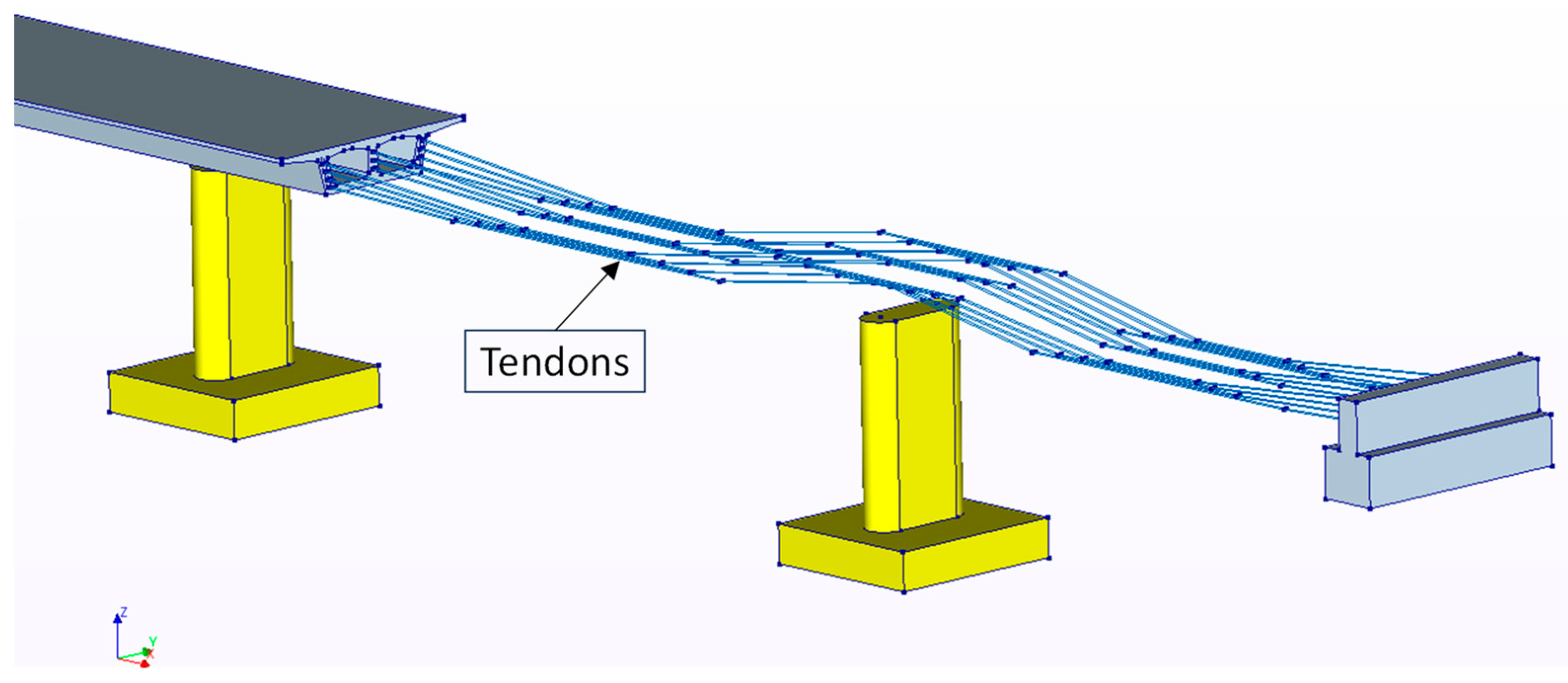
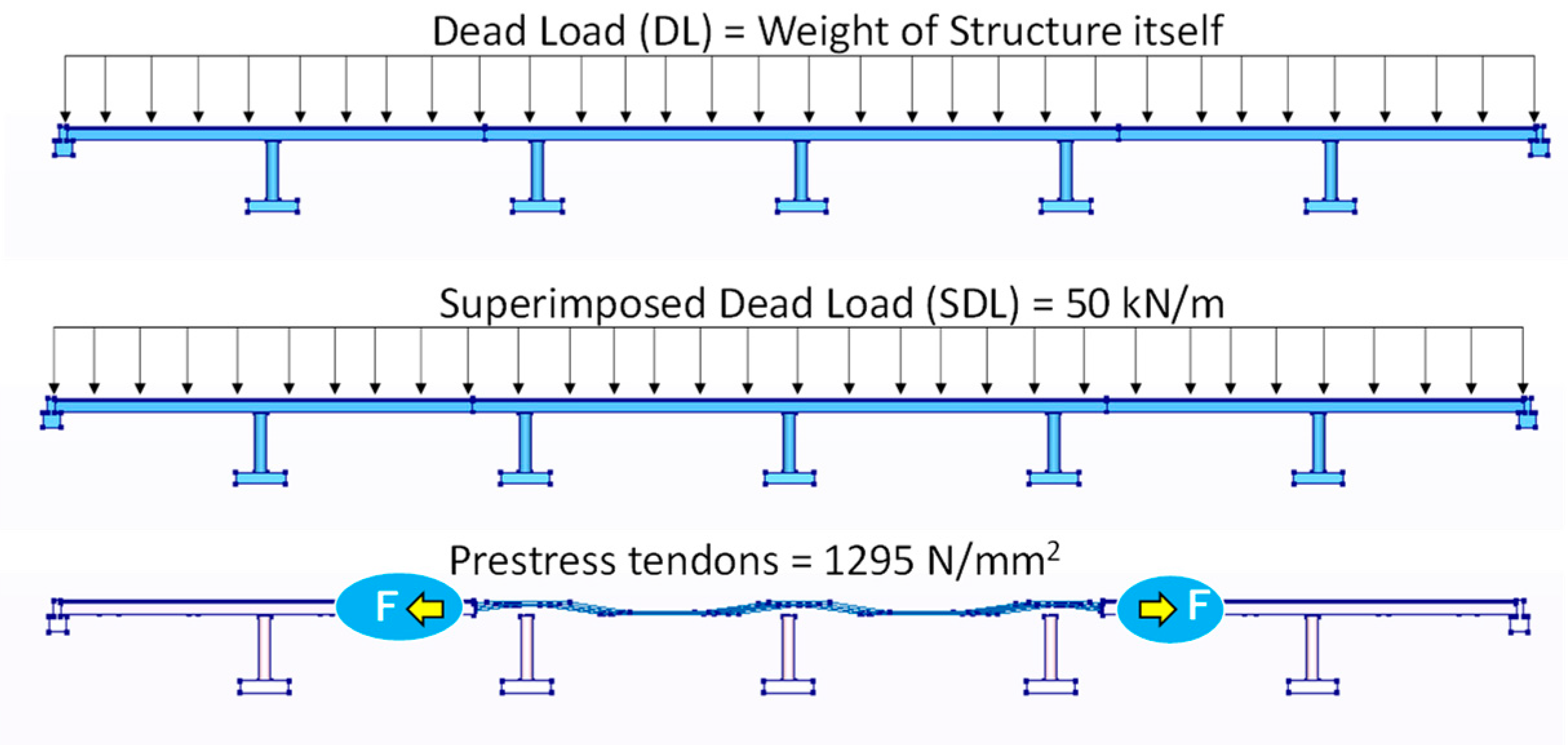
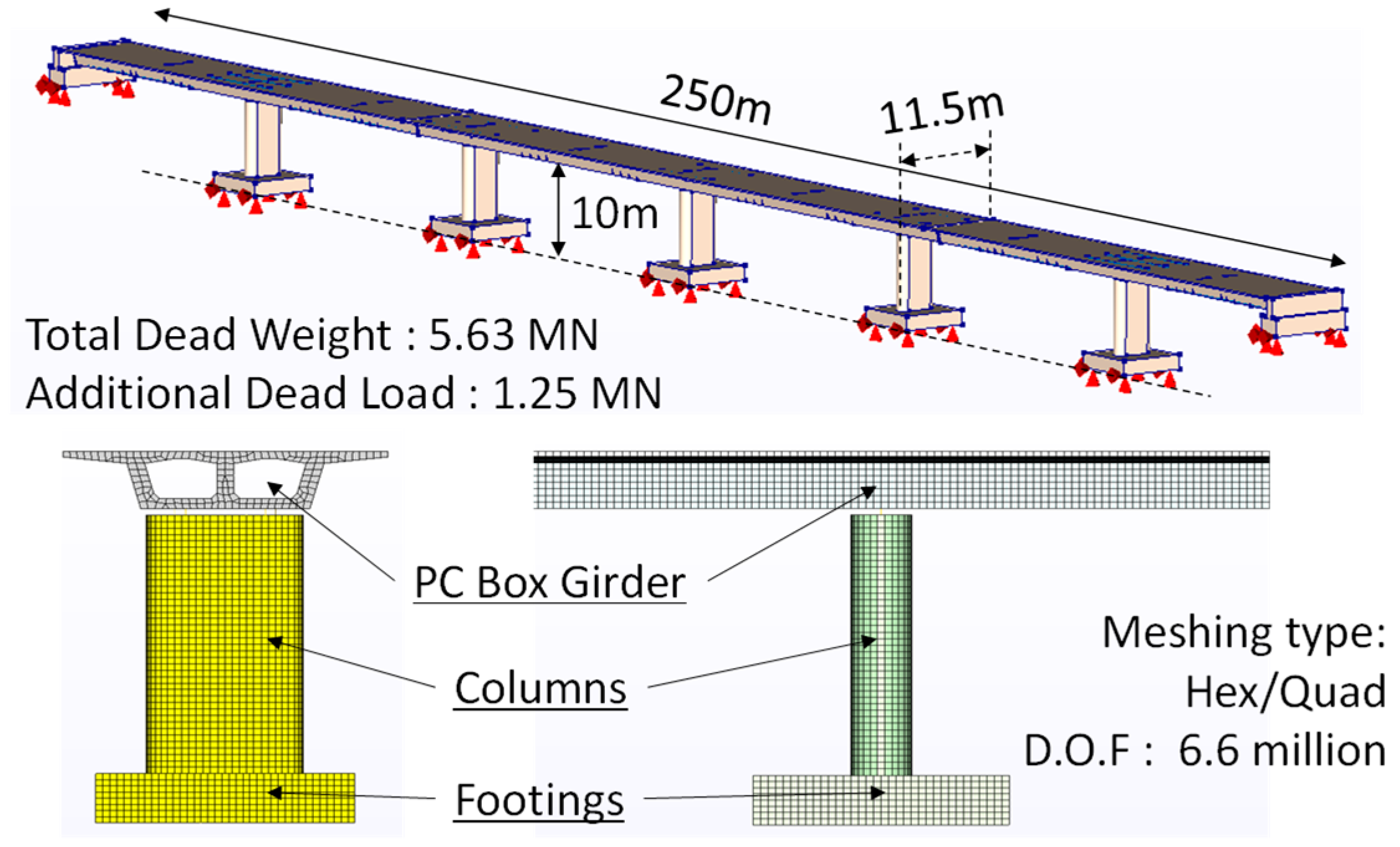
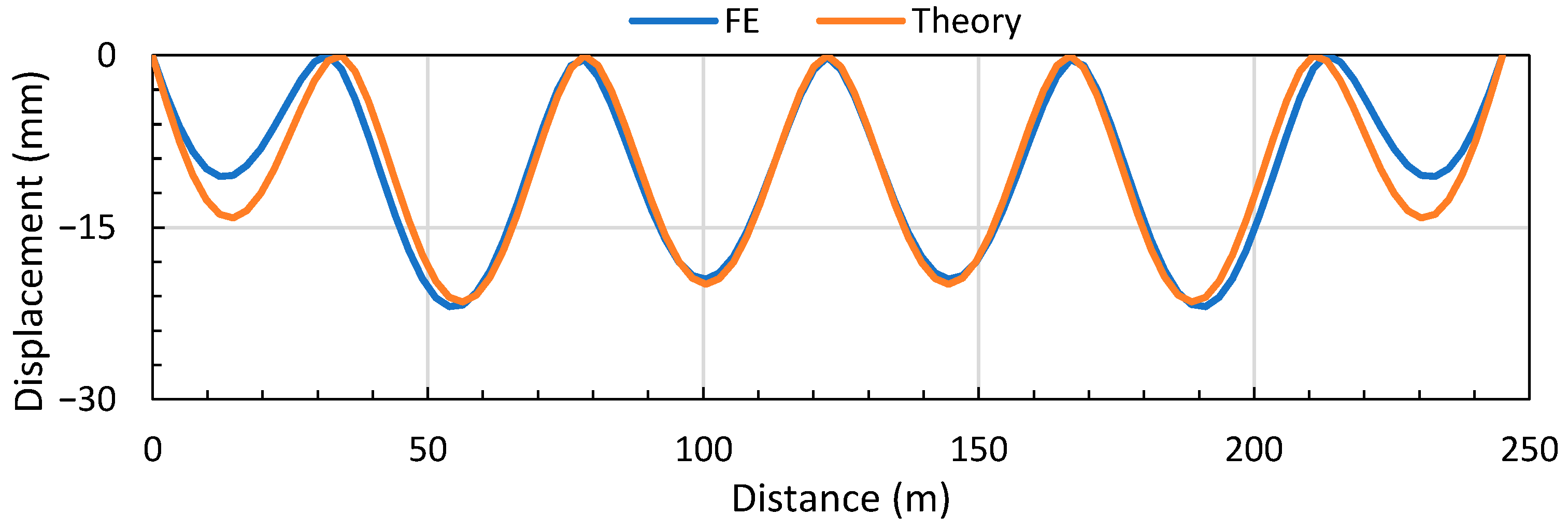
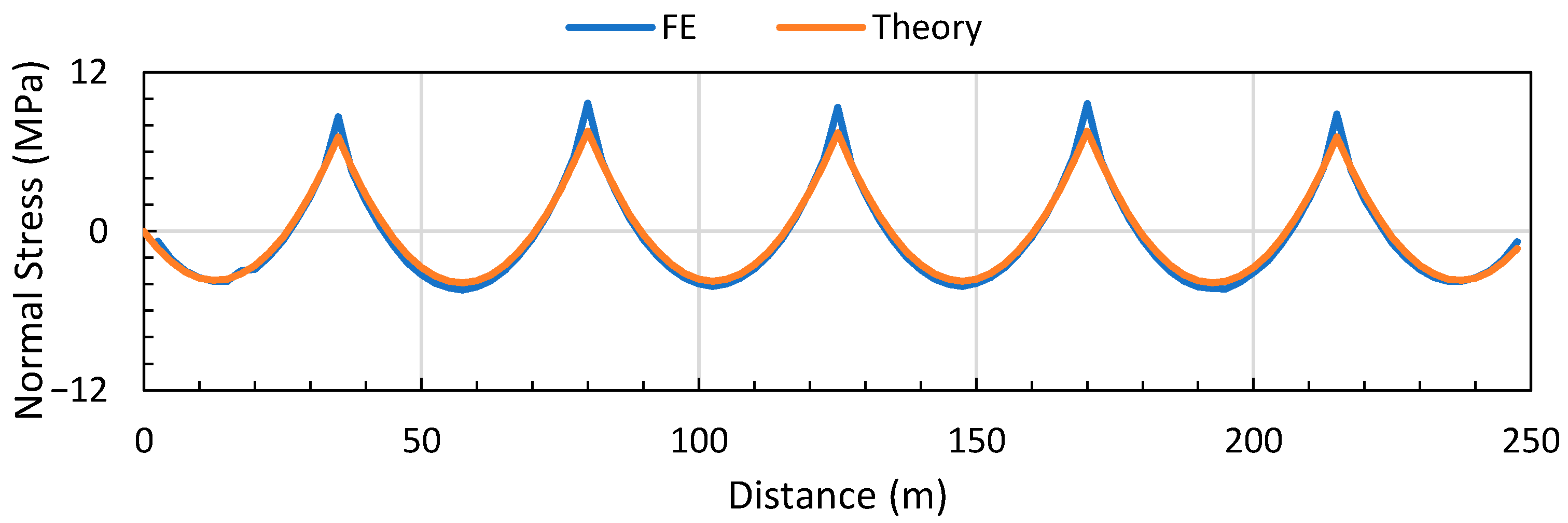
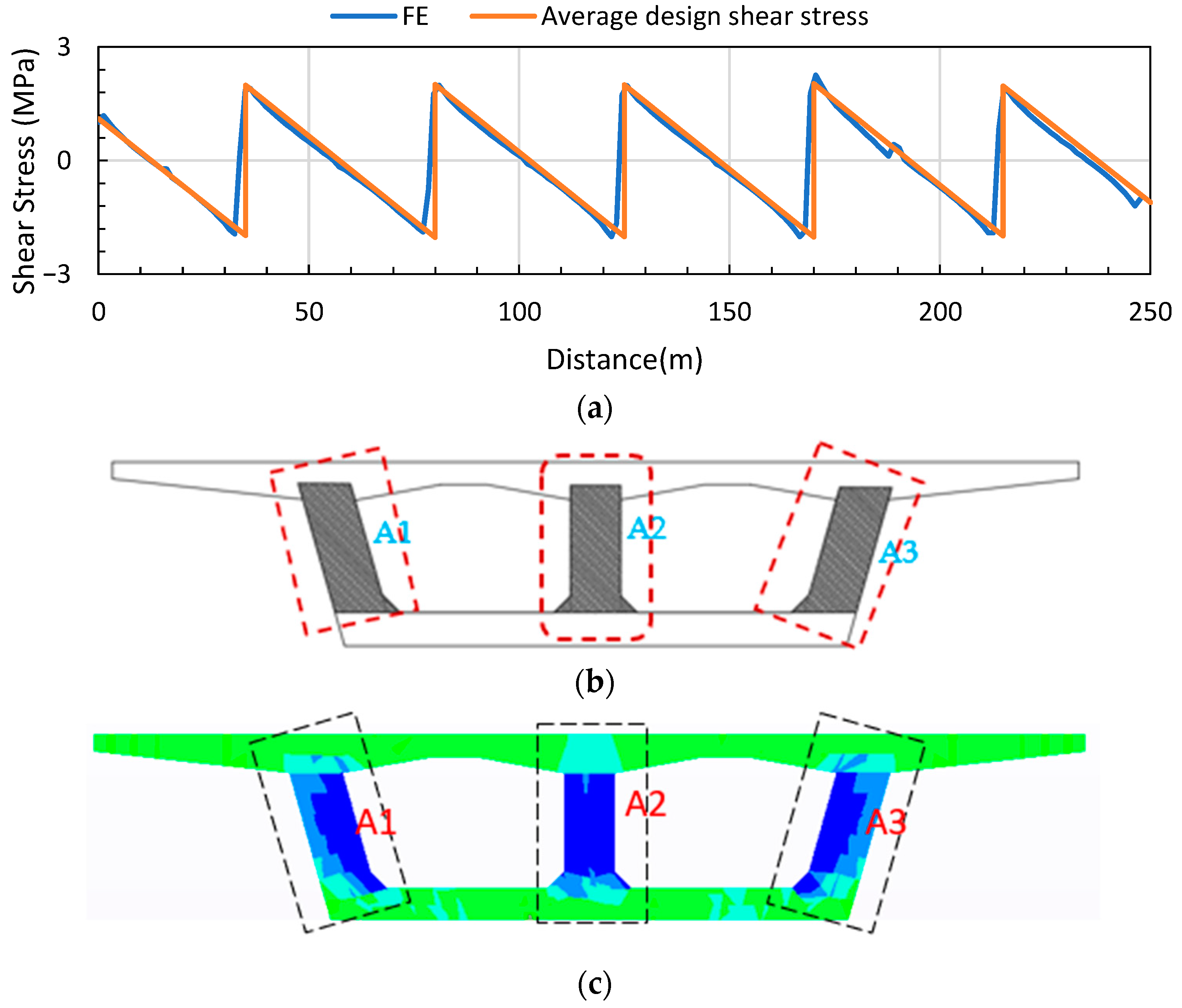
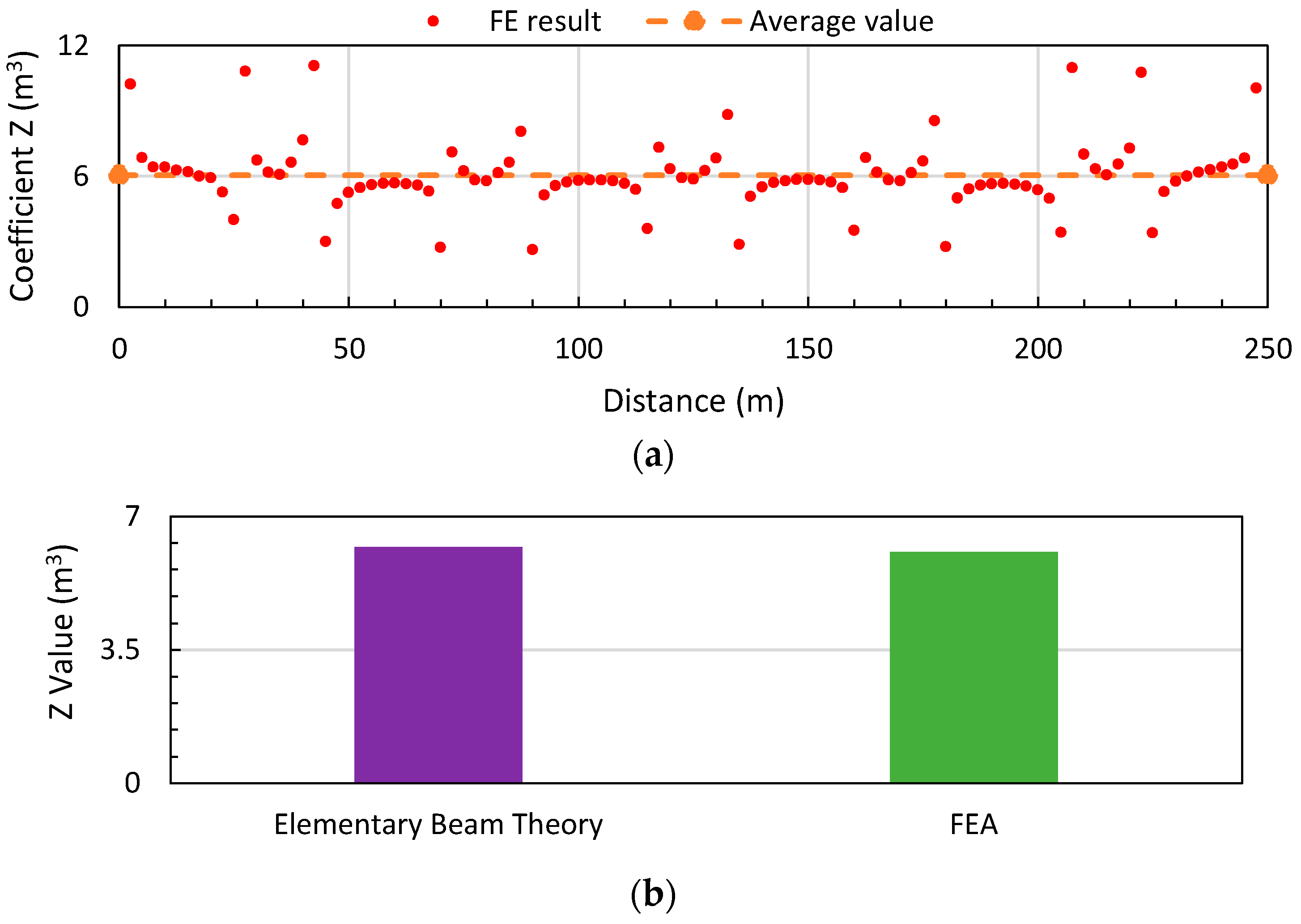

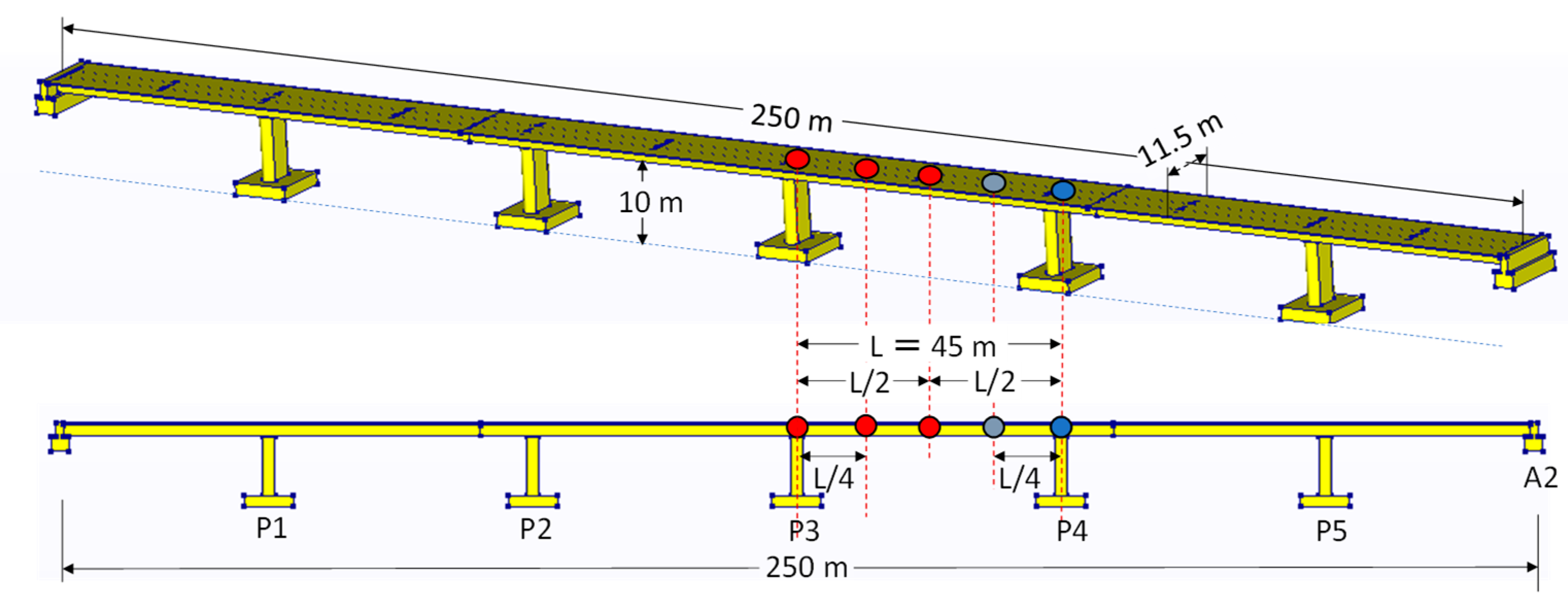
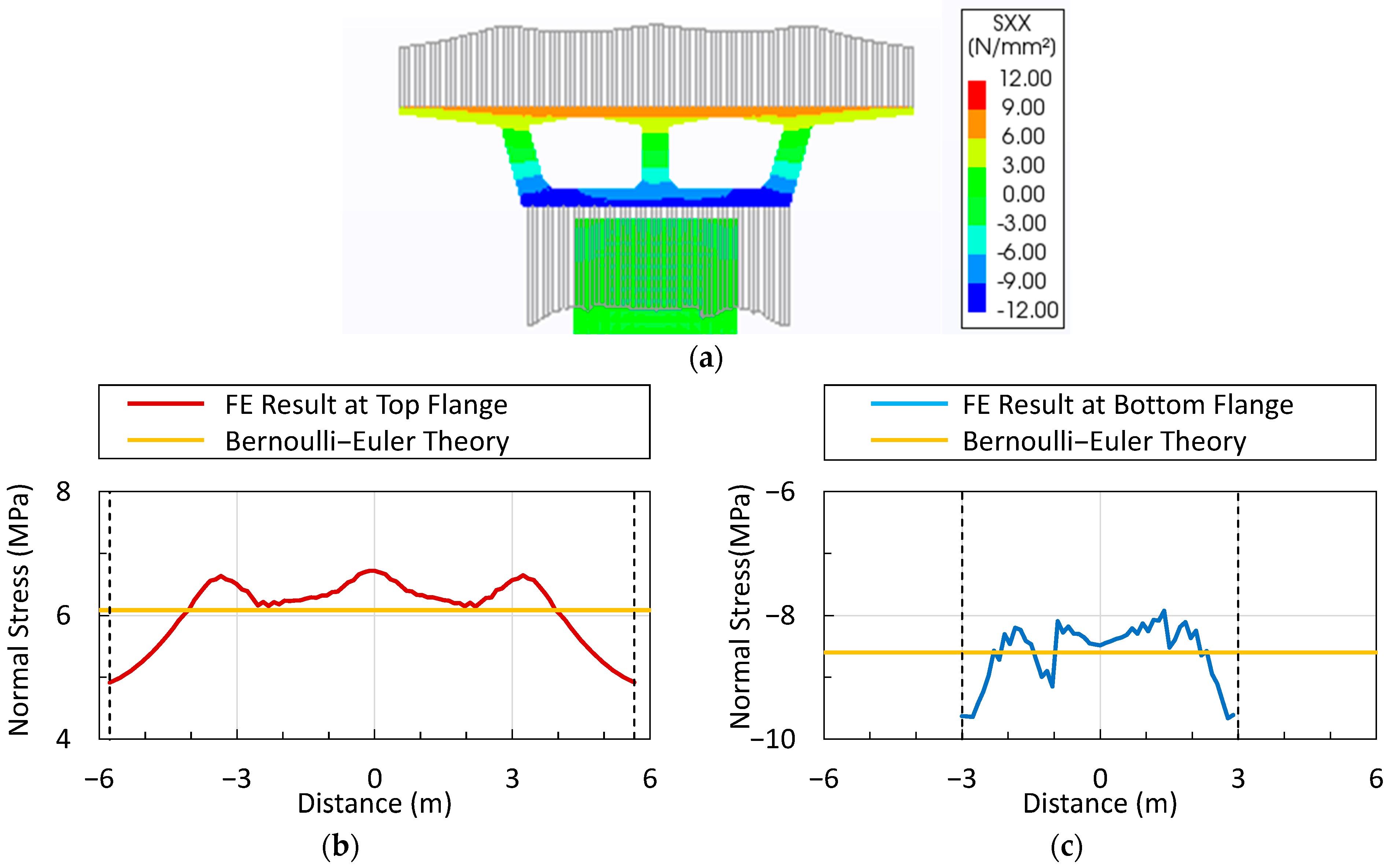
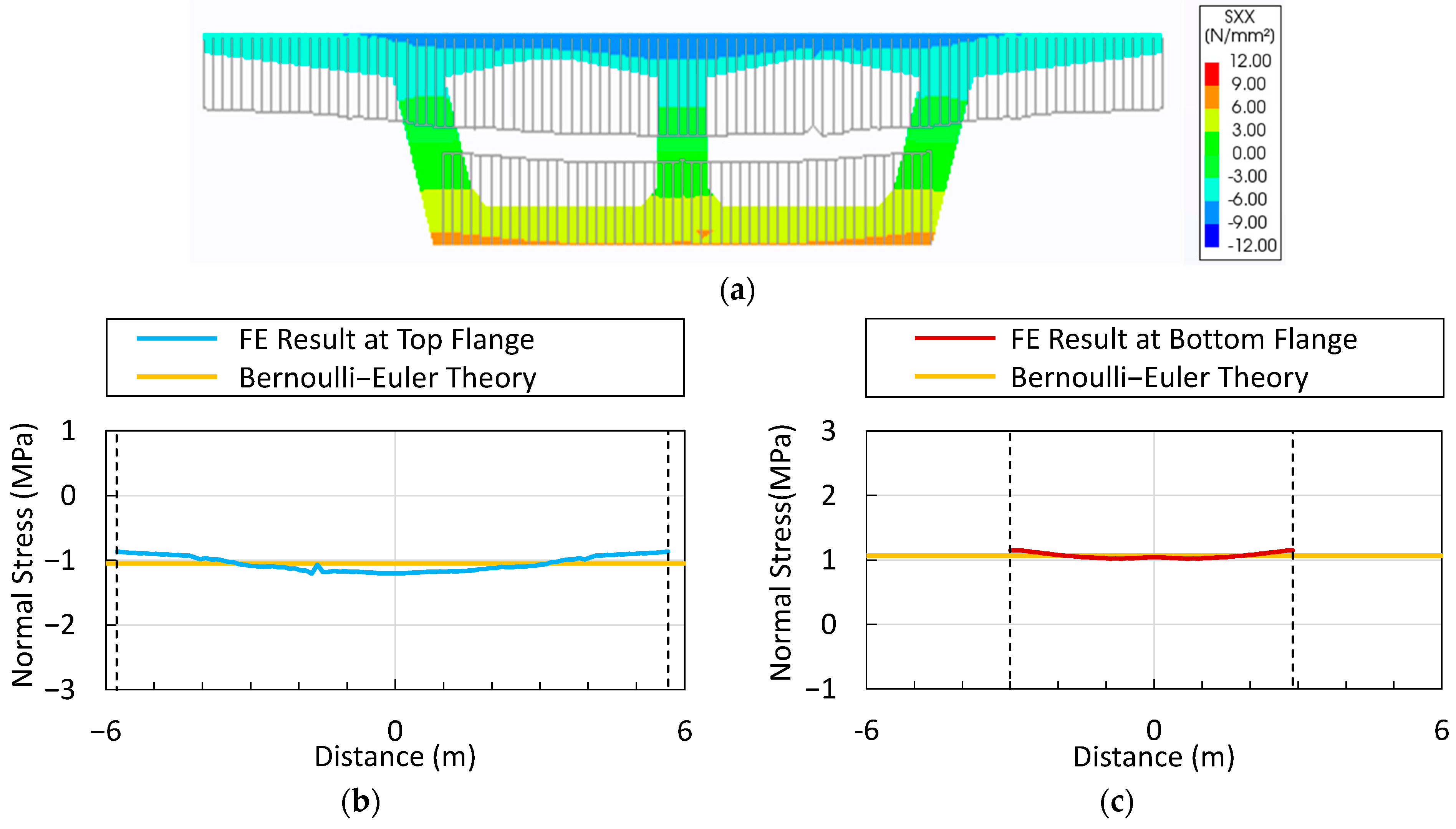

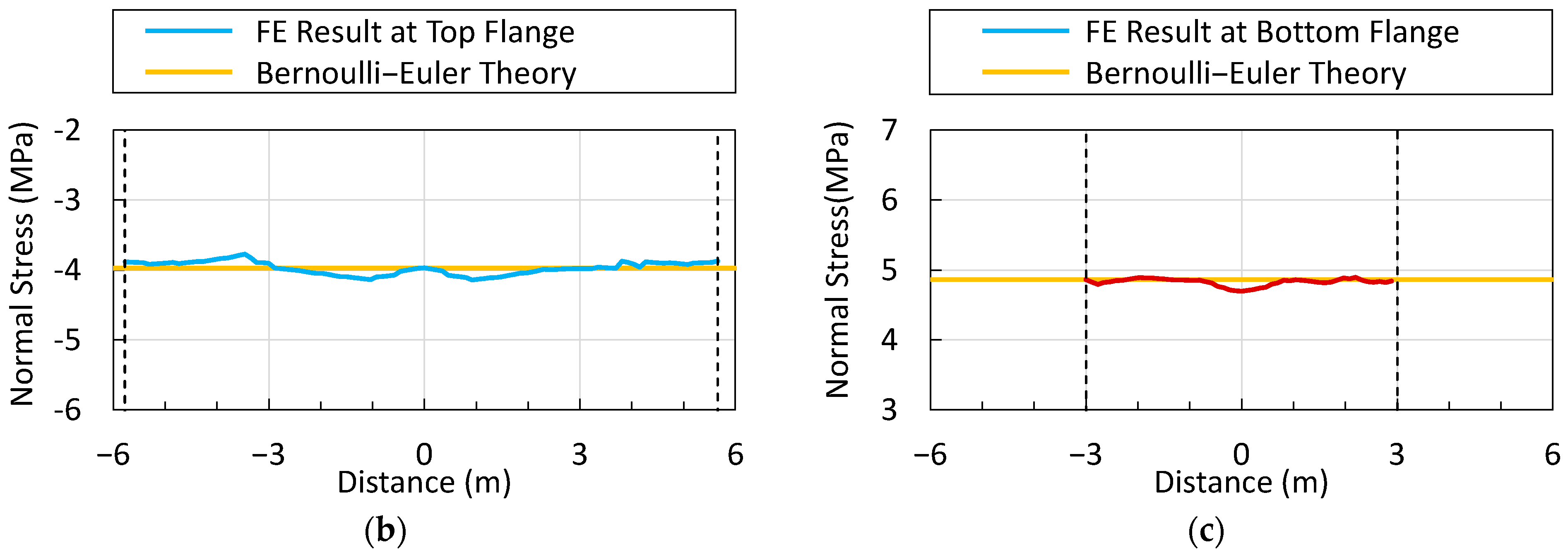

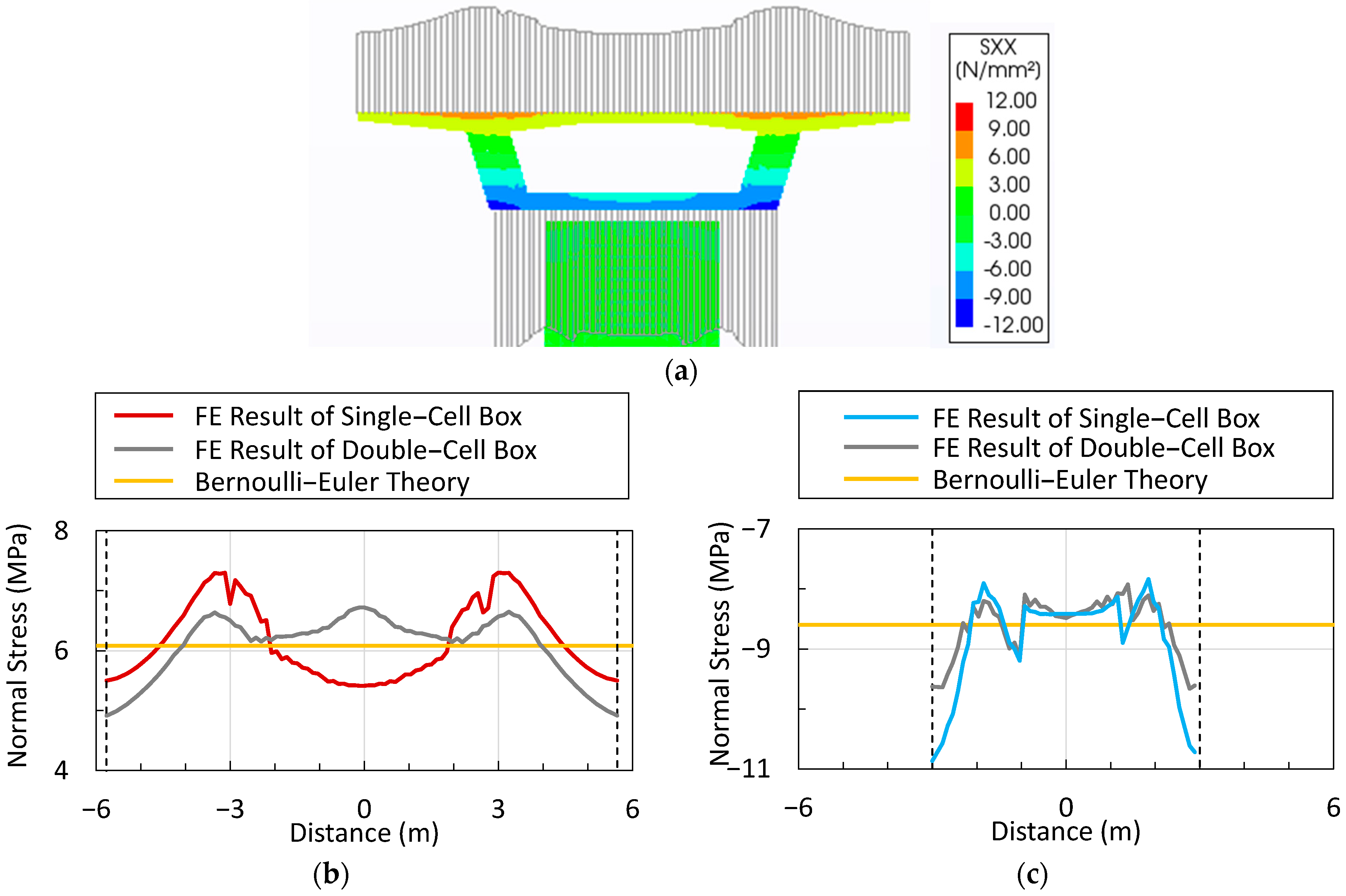
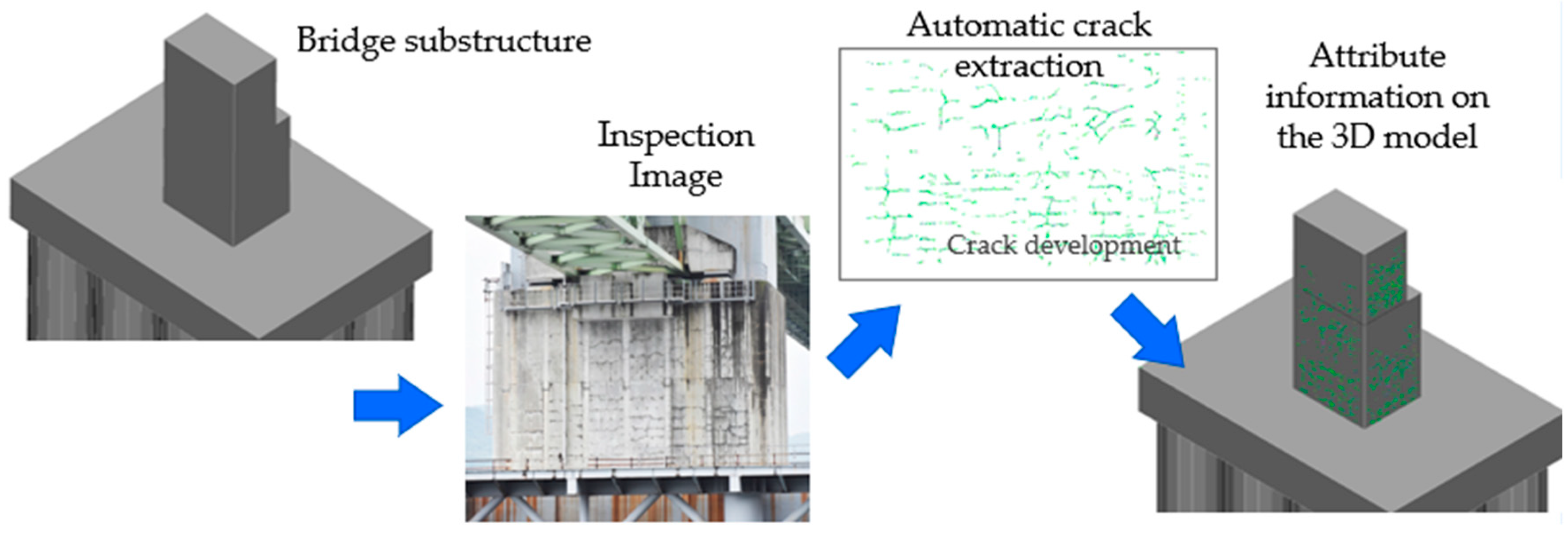
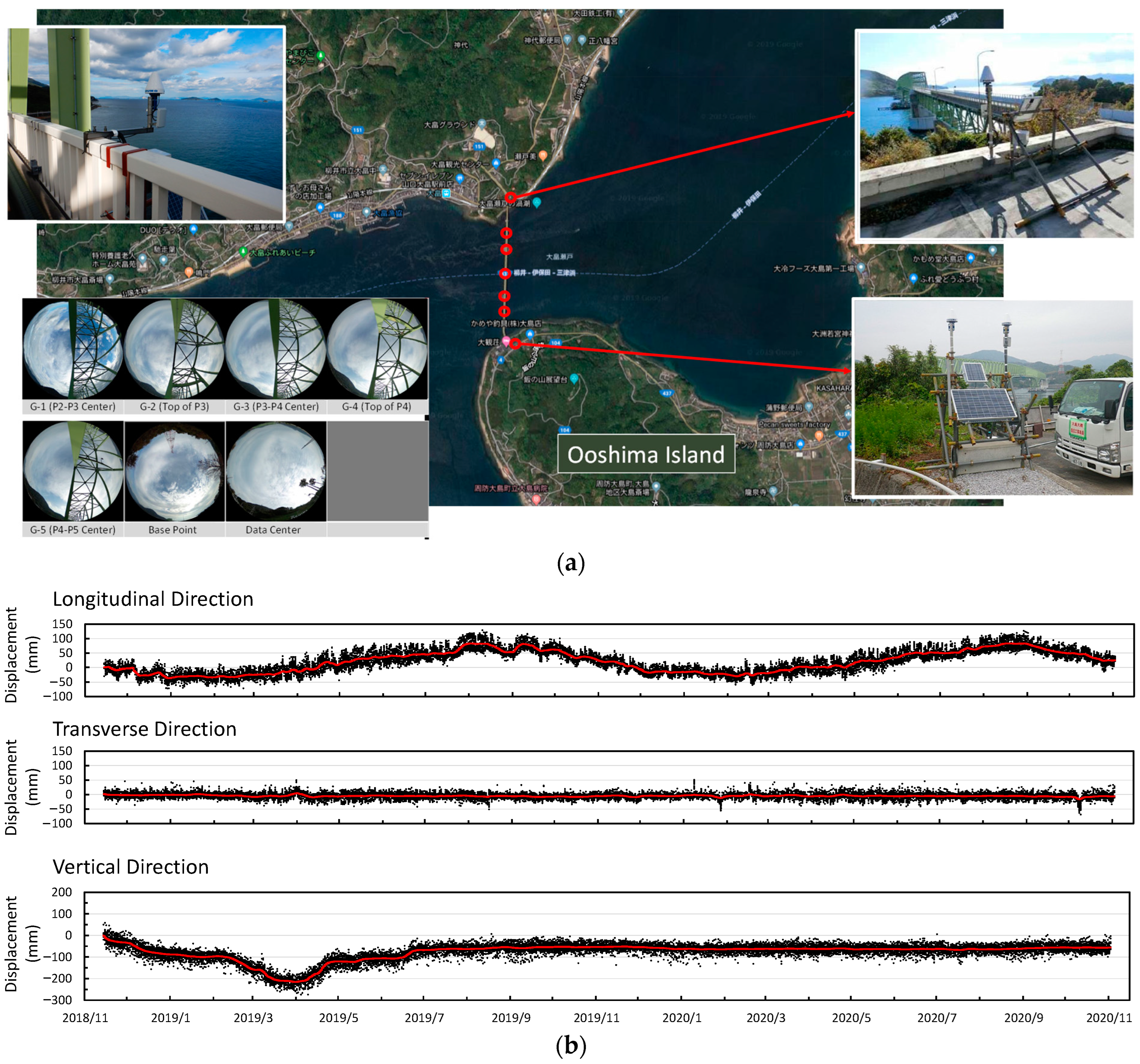
| No. | Type of Structure | Materials | |
|---|---|---|---|
| 1 | Superstructure | Concrete (fc) | 36 MPa |
| Poisson’s ratio | 0.2 | ||
| Mass density | 2500 kg/m3 | ||
| 2 | Substructure | Concrete | 30 MPa |
| Poisson’s ratio | 0.2 | ||
| Mass density | 2500 kg/m3 |
| Main Tendon | ||
|---|---|---|
| Type | SWPR7BL 12S15.2mm | |
| Tensile stress | 1850 (N/mm2) | |
| Yield strength | 1600 (N/mm2) | |
| Allowable tensile stress | At the time of prestressing | 1440 (N/mm2) |
| Just after prestressing | 1295 (N/mm2) | |
| Design load | 1110 (N/mm2) |
| Names | Types |
|---|---|
| Analysis | Linear static |
| Dimension | Three dimensions |
| Composed element | Solid |
| Mesh order | Linear |
| Mesh size | 0.25 m |
| D.O. F | 6.6 million |
Disclaimer/Publisher’s Note: The statements, opinions and data contained in all publications are solely those of the individual author(s) and contributor(s) and not of MDPI and/or the editor(s). MDPI and/or the editor(s) disclaim responsibility for any injury to people or property resulting from any ideas, methods, instructions or products referred to in the content. |
© 2023 by the authors. Licensee MDPI, Basel, Switzerland. This article is an open access article distributed under the terms and conditions of the Creative Commons Attribution (CC BY) license (https://creativecommons.org/licenses/by/4.0/).
Share and Cite
Tita, E.E.; Watanabe, G.; Shao, P.; Arii, K. Development and Application of Digital Twin–BIM Technology for Bridge Management. Appl. Sci. 2023, 13, 7435. https://doi.org/10.3390/app13137435
Tita EE, Watanabe G, Shao P, Arii K. Development and Application of Digital Twin–BIM Technology for Bridge Management. Applied Sciences. 2023; 13(13):7435. https://doi.org/10.3390/app13137435
Chicago/Turabian StyleTita, Elfrido Elias, Gakuho Watanabe, Peilun Shao, and Kenji Arii. 2023. "Development and Application of Digital Twin–BIM Technology for Bridge Management" Applied Sciences 13, no. 13: 7435. https://doi.org/10.3390/app13137435
APA StyleTita, E. E., Watanabe, G., Shao, P., & Arii, K. (2023). Development and Application of Digital Twin–BIM Technology for Bridge Management. Applied Sciences, 13(13), 7435. https://doi.org/10.3390/app13137435







